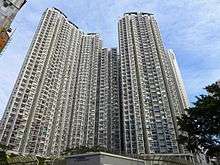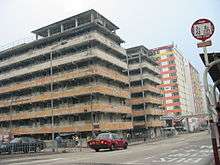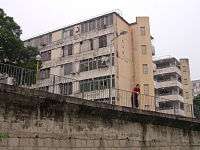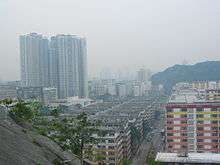Shek Kip Mei Estate
| Shek Kip Mei Estate | |||||||
|
Shek Kip Mei Estate after redevelopment in 2012 | |||||||
| Chinese | 石硤尾邨 | ||||||
|---|---|---|---|---|---|---|---|
| |||||||
Shek Kip Mei Estate is the first public housing estate in Hong Kong.[1] It is located in Sham Shui Po and is under the management of the Hong Kong Housing Authority. The estate was constructed as a result of a fire in Shek Kip Mei in 1953, to settle the families of inhabitants in the squats over the hill who lost their homes in one night.
Originally constructed in 1953 to alleviate the immediate housing need, the units in this "Mark I" estate were utilitarian. Redevelopment of the estate commenced in 1972, with new towers coming on stream between 1979 and 1982.[2] Site 1 of redevelopment was occupied in 2007.
The estate now consists of 26 blocks, containing 7,363 units/flats of between 11.1 and 55.7 square metres in floor area. The estate has an authorised capacity of 13,900[3].
History
.jpg)

Following the Second World War, a large number of migrants from the mainland arrived in Hong Kong. Due to the lack of housing policy, and thus non-availability of affordable housing, the migrants lived illegally in wooden shanties in a hillside ghetto in the Sham Shui Po area. Poor facilities, insanitary conditions, the high density of huts represented a serious safety hazard. On 24 December 1953, the ghetto caught fire. The blaze lasted for six hours and was put under control on 25 December, at around 2:30 am. It left an estimated 53,000 people without shelter.
Consequently, the Colonial government built a 29-block resettlement estate on the site of the burnt-down shanties to house the homeless victims.[4] Eight blocks (Blocks A to H), now renumbered as Blocks 10 through 13 and 35 through to 41, were constructed with the financial aid of the United Nations. These 7 storey blocks were constructed in an 'H' configuration consisting of 2 residential wings, with communal sanitary facilities linking them. Later towers were constructed with the single block configuration.
The massive fire gave birth formally to the public housing policy of the Government. In 1961, the subsidised rent policy was launched with the construction of 7 towers at the junction of Tai Hang Road West and Nam Cheong Street. The Shek Kip Mei Estate was subdivided into "Upper" and "Lower" estates, with the Upper estate being designated a "low-rent estate" (廉租屋邨), and the Lower estate was designated a "Resettlement estate" (徙置屋邨). Occupation of these blocks commenced in 1963.
Housing units were little more than small cubicles, and the original plan was to allocate 24 square feet (2.2 m2) per adult and half that for each child under 12.[5] However, they were in reality often occupied by more than one family due to the extreme shortage of available housing.[6] Facilities and sanitation were primitive, and communal.
Until the establishment of the Housing Authority in 1973, Hong Kong's public housing was administered by the Resettlement Department. By that time, eleven old blocks of the estate had been pulled down, and modernisation of 18 blocks of the resettlement estate had commenced. Phased re-occupation of the re-numbered estate took place between 1978 and 1984. The distinction between "Upper" and "Lower" estates ceased to exist henceforth. Mei Yu House (美如樓) and Mei Ying House (美映樓) representing the latest phase, was built on the location of Blocks 1 – 7 (the resettlement estate), and was mostly occupied on 18 July 2006.
All remaining 1950's blocks were demolished since 20 June 2007, excluding Block 41, which is reserved for further revitalization.
Conservation
Block 41 of the estate, Mei Ho House (美荷樓), the last remaining example of the "Mark II" building in a single-block configuration, has been listed as a Grade I historic building,[7] and will be preserved tentatively as a record of Hong Kong's public housing development. In 2008, it was part of the seven buildings of Batch I of the Hong Kong Government's Revitalising Historic Buildings Through Partnership Scheme[8] seeking adaptive reuse of government-owned historic buildings. On 17 February 2009, the government declared that the building would be used by the Hong Kong Youth Hostels Association as "City Hostel". The capital cost of the project was estimated at HK$192.3 million. Estimated completion time was early 2012.[9] The hostel was finally opened in December 2013.[10]
Blocks
As of 2015 the estate has 17 blocks, plus the preserved Block 41 presently in use as a youth hostel. The 17 housing blocks provide 9,200 public rental flats accommodating a design population of 22,500.
| English name | Chinese Name | Type | Completion | Notes |
|---|---|---|---|---|
| Block 19 | Old slab | |||
| Block 20 | ||||
| Block 21 | ||||
| Block 22 | ||||
| Block 23 | ||||
| Block 24 | ||||
| Block 41 | Mark I | Student hostel | ||
| Block 42 | Old slab | |||
| Block 43 | ||||
| Block 44 | ||||
| Mei Yue House | Non-standard | 2006 | ||
| Mei Ying House | ||||
| Mei Leong House | 2012 | |||
| Mei Sang House | ||||
| Mei Shing House | ||||
| Mei Wui House | ||||
| Mei Yick House | ||||
| Mei Yin House | ||||
See also
- List of public housing estates in Hong Kong
- Jockey Club Creative Arts Centre, housed in the former Shek Kip Mei Factory Estate
References
- ↑ Hong Kong Housing Authority – Transformation of Shek Kip Mei Estate
- ↑ Choi, Barry (27 August 1975). "Thousands to get new estate homes" (PDF). South China Morning Post. Retrieved 7 February 2007.
- ↑ "Estate description". Hong Kong Housing Authority. current. Retrieved 7 February 2007. Check date values in:
|date=(help) - ↑ Choi, Barry (30 June 1975). "Housing means more than a roof" (PDF). South China Morning Post. Retrieved 7 February 2007.
- ↑ Choi, Barry (14 October 1978). "Focus on small flats" (PDF). South China Morning Post. Retrieved 7 February 2007.
- ↑ Choi, Barry (13 August 1973). "Vital task is to satisfy slum dwellers who see luxury on doorstep" (PDF). South China Morning Post. Retrieved 7 February 2007.
- ↑ List of Graded Historic Buildings in Hong Kong (as at 6 November 2009)
- ↑ Conserve and Revitalise Hong Kong Heritage: Batch I of Revitalisation Scheme
- ↑ Batch I of Revitalisation Scheme – Result of Selection – Mei Ho House as City Hostel
- ↑ Revitalization Project - Milestones
Further reading
- Castells, Manuel (1990). The Shek Kip Mei Syndrome: Economic Development and Public Housing in Hong Kong and Singapore. London: Pion. ISBN 978-0-85086-135-8.
- Smart, Alan (2006). The Shek Kip Mei Myth. Hong Kong: Hong Kong University Press. ISBN 978-962-209-793-3.
- Yu, Vincent (2007). 我住石硤尾, 1954-2006 = Our Home, Shek Kip Mei 1954-2006. Hong Kong: MCCM Creations. ISBN 978-988-99266-3-2.
- Wolf, Michael (2009). Hong Kong Inside Outside. Berlin: Peperoni Books. ISBN 978-3-941825-04-8.
External links
| Wikimedia Commons has media related to Shek Kip Mei Estate. |
- Home in Hong Kong. Canadian Broadcasting Corporation, 2004.
- Photo gallery of Shek Kip Mei Estate
- Shek Kip Mei Estate: Taste the 60s and 70s in the old housing
- Virtual tour of Block 41
- Mei Ho House website
Gallery
 Block 14
Block 14 Block 17
Block 17 Block 18
Block 18 Block 22
Block 22 Block 25
Block 25 Blocks 27 & 28
Blocks 27 & 28 Block 34
Block 34 Block 37
Block 37 Demolished Block 38
Demolished Block 38 Blocks 39 & 40
Blocks 39 & 40 Block 41 Mei Ho House
Block 41 Mei Ho House Block 44
Block 44 Rebuilt Mei Yu House
Rebuilt Mei Yu House Rebuilt Mei Yu House
Rebuilt Mei Yu House Distant vista of Shek Kip Mei Estate
Distant vista of Shek Kip Mei Estate Distant vista of Shek Kip Mei Estate
Distant vista of Shek Kip Mei Estate Phase one building
Phase one building
Coordinates: 22°20′03″N 114°10′07″E / 22.33417°N 114.16861°E